
PCD1
-
How to know whether the circuit board of the PCD is fitted with a Swissbit micro-SD memory card? (FAQ #102070)
It is only possible to determine whether the PCD's circuit board is fitted with a Swissbit micro-SD memory card by visual inspection.
The attached document describes how to know whether the circuit board of the PCD is fitted with a Swissbit micro-SD memory card.
-
How to copy csv-Files and Webeditorproject files which are stored on the Intflash of a PCD, if you are replacing an internal micro-SD memory card which is used on the circuit board of the PCD? (FAQ #102069)
The attached document describes how to proceed if you want to copy csv-Files (e.g., from HDLog) and Webeditorproject files which are stored on the Intflash of a PCD.
This could be useful if you are replacing an internal micro-SD memory card which is used on the circuit board of the PCD and you want to re-use the files stored on the old micro-SD memory card.
-
What is stored on the micro-SD memory card which is used on the circuit board of the PCD? (FAQ #102068)
Newer PCD types and newer PCD7.D4xx devices have micro-SD memory card (uSD) on the PCB (printed circuit boards)
The following data’s are stored on the this uSD card on the PCD’s PCB:
- Firmware for the PCD
- Device configurator settings (PG5)
- Application program done with PG5
- Webeditor 8 project (PG5)
- DATA (e.g HDLog) created by the application program in runtime
- Setup, Calibration (PCD7.D443, PCD7.D450, PCD.D470)
- Program Backup on internal Flash
-
How can the micro SD memory card on the circuit board of a PCD controller be replaced? (FAQ #102067)
In some cases, it is necessary to replace the micro-SD memory card (uSD) of the PCD.

This FAQ describes how to replace the micro-SD memory card (uSD) which is mounted on the PCD controller's PCB (printed circuit boards)
The attached .pdf describes how to replace the micro-SD memory card (uSD) used on the PCB of the PCD
-
On a PCD2.M4560 or PCD3.M5560, why the measured PT100 temperature values are not correct if the PT100 sensors are connected to PCD2.W220Z18 or PCD3.W220Z18 modules? (FAQ #102052)
If the PCD2/3.W220Z18 card is plugged in to a ‘Power PCD‘ or a PCD2.C1000 or PCD2.C2000 and if all 8 analog inputs channels of the PCD2/3.W220Z18 module are connected to 8 PT100 sensors then the measured PT100 temperature values of the 8 channels are not correct.
‘Power PCD’s’ are:
- PCD1.M2x20, PCD1.M2160, PCD1.M2220-C15
- PCD2.M5540, PCD2.M5440, PCD2.M4160, PCD2.M4560
- PCD3.Mxx60
To solve the issue, use and connect only up to 7 PT100 sensors to the PCD2/3.W220Z18 or do use a PCD2/3.W350 module, if all 8 PT100 are needed.
On the ‘old’ PCD’s like PCD2.M170 or PCD3.M5540 the PCD internal power supply V+ was at 24V
On the ‘new’ ‘Power-PCD’s’ and the PCD2.C1000 and PCD2.C2000 the V+ is 16,5V
The electrical design of the PCD2/3.W220Z18 was done in that the way, that the internal power V+ of 24V was required to handle all 8 PT100 channels.
Since the ‘Power PCD’s’ and the PCD2.C1000/C2000 have a V+ of 16,5V the driver on the PCD2/3.W220Z18 don’t have enough power to handle all 8 PT100 signals correctly.
To solve the issue, use and connect only up to 7 PT100 sensors to the PCD2/3.W220Z18 or do use a PCD2/3.W350 module, if all 8 PT100 are needed.
-
Are devices or software developed from Saia-Burgess Controls affected by the Domain Name System (DNS) vulnerabilities, published with the report name NAME:WRECK? (FAQ #102046)
No
Saia-Burgess Controls devices and software are not affected from Domain Name System (DNS) vulnerabilities published with the report name NAME:WRECK
-
-
Are devices or software developed from Saia-Burgess Controls affected by AMNESIA:33 or SUNBURST? (FAQ #102042)
No, Saia-Burgess Controls devices and software are not affected from AMNESIA:33 or from SUNBURST
- AMNESIA:33: Describes Security vulnerabilities in TCP/IP stacks
- SUNBURST: Is a trojan
-
Are SBC devices affected by the zero-day vulnerabilities ‘Ripple20’, related to the low-level TCP/IP software library developed by Treck, Inc.? (FAQ #102036)
No, SBC devices are not affected from the Ripple20 zero-day vulnerabilities since none of our products uses the TCP/IP software library developed by Treck, Inc.
-
Inputs of a W525 could be perturbed from an other input? (FAQ #102007)
With some specific sensor and configuration, the inputs of a module PCD2/3.W525 could perturbate an other input of the same module
Module PCD2/3.W525 are not designed as other analog input modules (as PCD2/3.W340 or W200 for example). Particularities of the module W525 are the following:
- Galvanic separation of inputs/outputs.
- Differential inputs/outputs.
For most of sensors, which are used in differential mode, no problem could be detected from other inputs.
With the use of non-differential sensor, when all (-) parts would be connected together, perturbation might be visible on another channel. As the W525 module has galvanic isolation and due to the design of the module, unwanted return current could appear and disturb other inputs.
If you experience such situation, there is a possibility to connect the (-) of your sensor to the gnd of the module. By doing it this, galvanic isolation of the whole module will not be valid anymore.
Therefore is a special configuration of the jumper possible.
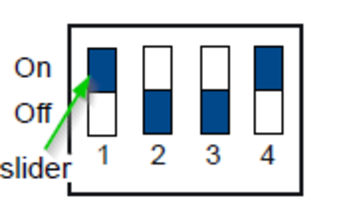
-
No Refresh from State of I/O's from E-Line Rio- Moduls after Fbox Update (FAQ #102001)
Fbox Update of the E-Line Library causes Problem with I/O refresh in Fupla
Symptoms
PG5 2.2.140 with E-Line Fbox Library V2.1.100.
After the automatical Fbox Update in the Fupla Editor, the Projekt will be Rebuilded and downloaded into the PCD without Errors.
Checking the Funktions Online, there is no Refresh for the States of Inputs and Funktion for the Outputs visible.
An Kommunikation Error is not indicated.Reason
An Error in the PG5 2.2.140 does not perform a clean update
Solution
Is described in FAQ 101994
In PG5 2.2.220 the Error is fixed
-
How should I configure the triac output of an E-line PCD1.G360x-C15 (FAQ #101984)
If you want to use the Triac on an Eline module here are the explanation how it is configurable and how it should be wired. For this example the Triac0 is used for a test with a lamp.
See on the following print screen the wiring to use the Triac. The Triac must be tested only with a charge! You can simply connect a lamp 24/230V AC on the TR0 and Nb connector.
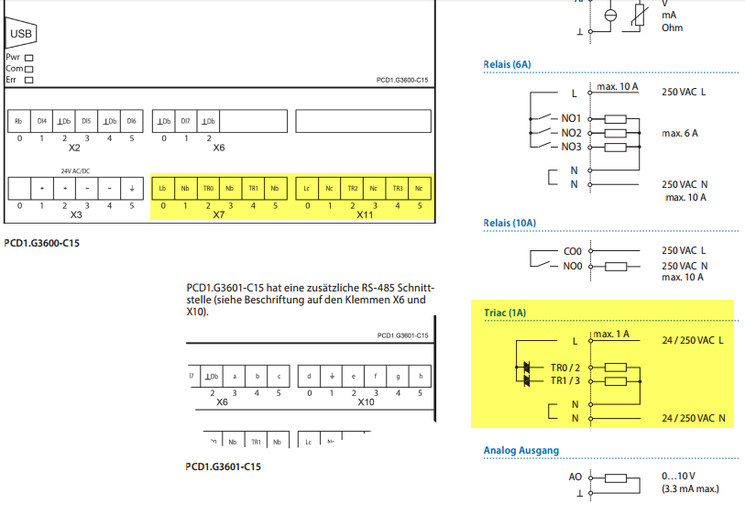
In the device configurator choose PWM or phase control.
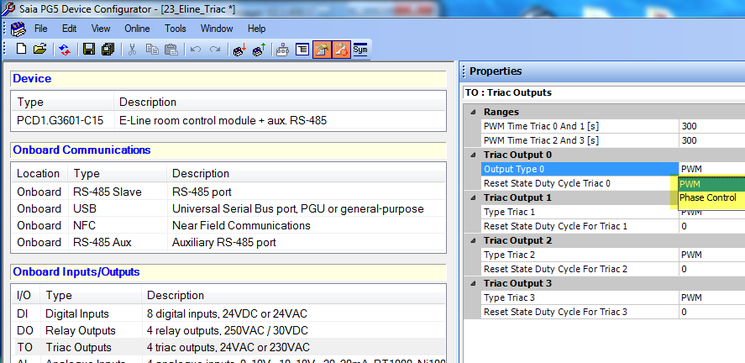
PWM:
Used for a slow PWM signal for radiator's valves
In the device configurator set the following settings:
Set the Triac Output 0 to PWM.
PWM Time Triac0 should be set between 30s - 600s. In this example it is set to 40s. It is the time for one PWM cycle.
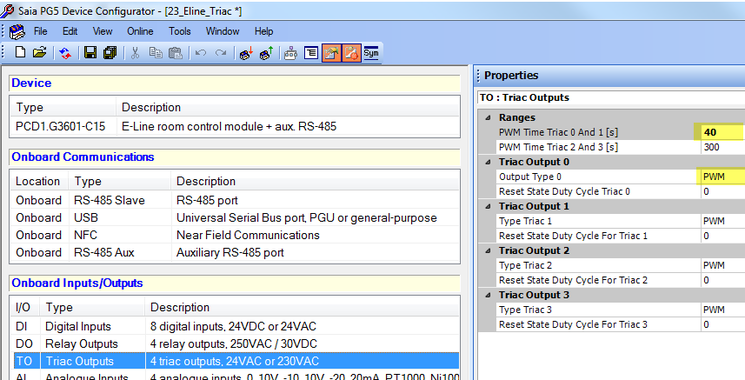
Download the device configurator and you can change the value of the register TriacDutyCycle0.
It could be found in the media mapping of the Eline module. This value can be set between 0-1000 (0-100%). In this example it is set to 250 --> 25%.
The impulse will be on for 25% of the cycle. It will look like on the following print screen.
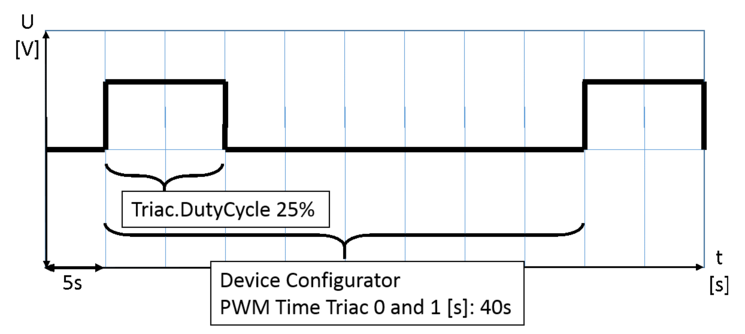
Phase control:
Used to dim a light for example.
In the device configurator set the following settings:
Set output Type 0 to phase control
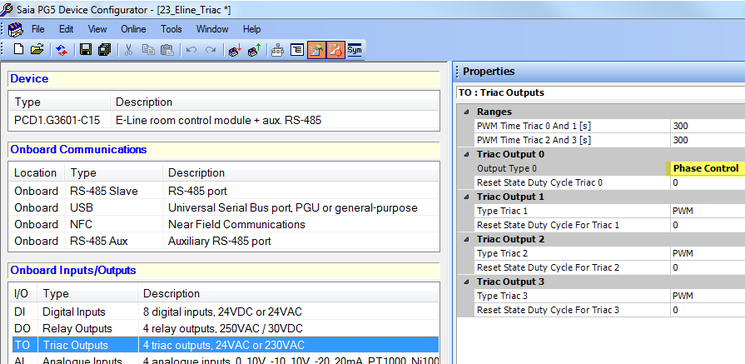
Download the device configurator and you can change the value of the register TriacDutyCycle0 of the media mapping of the Eline module. This value can be set between 0-1000 (0-100%).
Dim the lamp by changing the TriacDutyCycle0 value.
1000 means lamp is On with 100%
500 means lamp is On with 50% etc.
-
Which FBox are supported by E-line? (FAQ #101967)
Due to the design of E-line family, some Fboxes are not supported.
Find below a list and a downloadable document
Concerned Products:
- PCD1.G1100-C15 Light and blind module
- PCD1.G360x-C15 Room module
- PCD1.F2611-C15 DALI module and aux. RS-485
- PCD1.W5300-C15 Analogue module
List of supported Fbox for E-lines Series
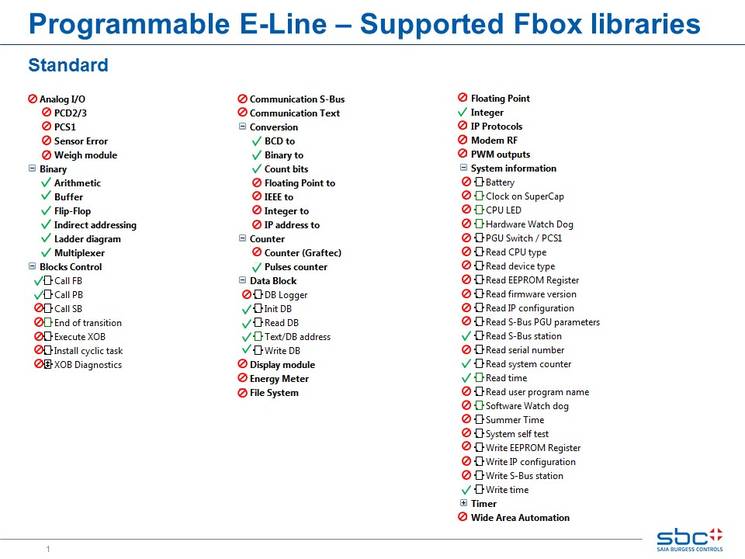
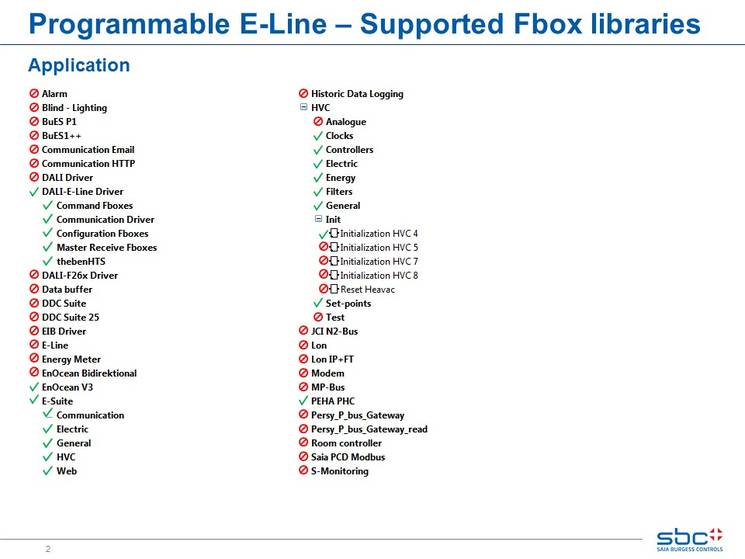
-
What are the maximum energy consumption values for Energy meters and Energy Managers/ E-controllers? (FAQ #101899)
Where is the counting limit for Energy meters and Energy Managers/ E-controllers?
What happens when they reach the limit?
The maximum energy consumption value for all counters is 9’999’999.
When a counter reaches this value, it will start counting with 0.
In the Energy Manager and in the E-Controller, the energy consumption value is handled in the firmware.
In runtime, the firmware detects only negative values.
A lower positive value is only detected during a reboot.
In this case, a counter change message appears.
Now you have two possibilities:
1:
You can do a manually reset of the counter value to 0.
That means you have to reject the proposed action on the user interface of the device.
=> A new file is created with a higher index by the firmware.
The history bar charts are lost and the visualization starts to redraw from the current day.2:
Anyway the firmware counts internally with floating point values.
The second possibility is to accept the appeared proposal from firmware.
=> The history bar charts stays, but the values on the counter and on the user interface aren’t the same anymore. -
Which Texts are writeable/editable during Runtime on a PCD? (FAQ #101801)
This FAQ explains under which circumstances, which texts are writeable/editable during runtime.
Non-Saia PCD® COSinus Systems (PCD1.M1xx, PCD2.M1xx)
With Flash or EPROM Memory plugged
- Texts < 4000 are not writeable in runtime
- Texts >= 4000 are writeable in runtime
With RAM Memory plugged
- Texts < 4000 are writeable in runtime but PG5 recognizes if one of these texts has changed*
- Texts >= 4000 are writeable in runtime
Saia PCD® COSinus-Systems
PCD3.Mxxx0 and PCD2.M5xx0
- Texts < 4000 are writeable in runtime but PG5 recognizes if one of these texts has changed*
- Texts >= 4000 are writeable in runtime
PCD3.Mxx60 and PCD1.M2xx0
- Texts are configurable in the Build Options, define First Writeable Text.
*If one of these texts have changed, PG5 will give a message when you want to go online with PG5 indicating that the
program is not the same. Also these texts will be overwritten when the program is downloaded again. -
Lifetime expectancy of the Renata Lithium battery on recent PCD compared to previous PCD generations (FAQ #101780)
It is correct that the indication of a low battery will appears earlier due to more accurate prediction on a new Saia PCD® COSinus system than before on a PCD2/1.M1xx.
There are two main reasons to explain this fact:
- The supervision function was improved
The new battery supervision function sets the battery under a very small load to predict the end of battery capacity. In term of battery capacity, this additional load is negligible, but allows the system to warn before the battery is really empty. That gives enough time to exchange the battery and preventing memory lost. This is not the case on the previous generation, where only the voltage was supervised.
- There is more memory to support
The recent systems have much larger memory; the resulting standby current to be supplied from the Battery increased short the time duration.
Summary of working principle with the Lithium Battery
System with passive battery supervision applied on the following PCD’s:
PCD1.M130, PCD1.M135, PCD2.M110, PCD2.M120 and PCD2.M150
The voltage of the battery is supervised.
SBC advise to change the battery all 1 - 3 years.System with active battery supervision since 2001 applied on the following PCD’s:
PCD1.M2xxx, PCD2.M170, PCD2.M480, PCD2.M5xxx, and PCD3.Mxxxx
If the 24VDC power is switched on, then the voltage of the battery is measured during short time all 12 seconds where the battery is submitted to a small discharge.
This allows to warn the application program before the capacity of the battery reach its end.
We estimate that in this case the battery has still two days of reserve capacity for the changing of the battery.
In most recent PCD's the battery change can be done from end-user keeping the 24VDC power supply of the PCD switched ON.
If during the battery change, the 24VDC power supply of the PCD remains switched ON then there is no lost of the SRAM content (means that the PCD medias does retain there values)A lost of the SRAM content (PCD medias like registers, flags and the application program [application program only if there is no application program stored in the Flash memory] does occurs only if the 24VDC power supply is switch off during the battery change.
The specifications in the manual concerning the typical life time of a Renata battery is still correct (1-3 years).
Today, on April 2013 we are able to give more precise lifetime expectancy for the battery for PCD’s produced since July 2012:Service conditions Lifetime expectancy of the battery a. continuous power OFF 24 Months b. power ON 8 hours on 5 days a week 34 Months c. continuous power ON 80 Months
However SBC advices to preventable change of the Lithium battery all 5 yearsNote that these values are set conservatively; longer lifetime of the battery can be achieved in the practice.
For PCD’s produced before July 2012, above mentioned times could be shorted by 20% due to larger SRam standby current.
The value of standby current is verified on each device during the production. -
How to dump the memory of a PCD (with Saia PCD® COSinus firmware)? (FAQ #100833)
The information provided in the history or the "Diagnostic file" of the PCD does not always give enough information for the firmware developpers to find the reason for e.g. a crash of a PCD. If more information is required in order to trace back a crash, a dump of the whole memory (SRAM, DRAM and FLASH) of a PCD can be done. This FAQ does apply to PCD1.M2, PCD2.M480, PCD2.M5xxx, PCD2.M45x0, PCD3 (including PCD3.Mxx60) and PCD7.D4xxxT5F (Programable MB-panels).
Working principle
For dumping the memory of one of the following systems a dedicated small executable SaiaDump.exe is available as standalone tool.- PCD1.M2
- PCD2.M480
- PCD2.M5
- PCD2.M45x0
- PCD3
- PCD3.Mxx60 (fast CPU)
- PCD7.D4xxxT5F (programmable MB-panels)
Usage of the stand alone tool SaiaDump.exe:
This tool is called by a batch file which will call an executable (SaiaDump.exe) with hardware specific parameters. The executable will establish an USB connection to the PCD and will read out the memory content. This content will be stored in 4 files and all these files will automatically be stored in a *.zip archive.General remark:
In order to obtain all necessary information it is important that the dump is made while the CPU's memory still contains the last information.
Since this information is lost (overwritten) when the PCD re-boots, it must be achieved that the PCD does not reboot in case of a crash (e.g. Bus Error or Kernel Error).
Therefore a specific SYSWR has been implemented.
This command is to be executed on the PCD e.g. in XOB 16 before a crash occurs (on every boot, because it is reset on each power off).
Software installation of SaiaDump.exe tool
- Download the archive "SaiaDump_V1_3_006_Rev211101.zip" from this FAQ
- Unpack the *.zip archive on your PC or Laptop
- In the extracted folder "SaiaDump" you'll find several batch files (e.g. RUN_DUMP.bat or RUN_DUMP_PCD1M2xx0.bat).
By double-clicking on the file RUN_DUMP.bat, a dump is started (make sure that PCD is connected with a USB cable and no PG5 is running)
After a successful dump a new *.zip archive with the name "PCDDump_date" will be stored in the same directory.
Please send this archive (it should contain four files with the extension *.blk or *.bin and a log file) to the support.
Preparing the PCD
In order to cause the PCD not to reboot in case of a crash, add the following lines to the code of your CPU (and remove the watchdogs, if present).
Alternatively, you can also add and link the file "DontRestartAfterCrash.src" which is contained in the folder "PCD_Preparation" off the "SaiaDump_exe.zip" to the concerned CPU in your PG5 project.$INIT ; Add the following lines to the XOB 16
SYSWR K 9999 ; Instruction to cause the PCD not to
K 1 ; reboot after a crash
$ENDINITThis instruction has been implemented first in PCD3 firmware version 03A.
Therefore please also make sure that FW version 03A or higher is installed on the system.
The SBC Dump tool can only dump the memory of a PCD that has boot loader version 035 (created in April 2006) or higher installed.
In case your PCD has a too old boot loader or if you are in doubt of the boot loader version of your PCD, please refer to FAQ 100680 in order to learn more about how to find out the boot loader version and how to update the boot loader version.
Dumping the PCD memory
After the next crash, the PCD will not re-boot anymore and will blink with all tree LEDs simultaneously instead. Please note that the SYSWR K 9999 (see above) must have been introduced before the crash and the LEDs must blink in this state! In this (and only in this) situation it is possible dumping the memory of the PCD:
Use of the stand alone tool SaiaDump.exe:
Launch the SaiaDump.exe for retrieving valuable debug information (it is also possible dumping the PCD if the PCD is in boot loader state or run for test purposes, but no valuable debug information can be retrieved from these files).
For launching the SBC Dump is should be enough to double-click the file RUN_DUMP.bat.
Additional information for PCD3.Mxxx7
The same tool can also be used for dumping the memory of a PCD3.Mxxx7. But note that the usage of the SYSWR listed above is not to be used.
FAQ updates- December 2021(Version 1_3_006_Rev211101)
- Support also the PCD2.M45x0 - March 2013 (version 1.3.006)
- Support also the PCD7.D4xxxT5F (programmable MB-panels) - July 2011 (version 1.3.005)
- created batch files for easy launch or the SBC Dump executable
- added log file creation during dump process - November 2010 (version 1.2)
- supports new hardware: PCD1.M2 and PCD3.Mxx60 (fast CPU)
- supports the new USB driver (for 64Bit OS)
- removed the firmware files from the package in order to make it smaller - June 2010 (version 1.1)
- increased SRAM memory Dump (2 MByte) for recent PCD systems (PCD3, PCD2.M5).
- update of firmware delivered in the package to 1.10.51. - Mai 2009
Version 1.0 of the SBC Dump: This version does also dump the internal SRAM of the PCD.
-
I forgot the password for my PCD/PCS! How can I access it again? (FAQ #100639)
The PCD CPUs can be protected with a password. Once the CPU is password protected it is not possible reading its hardware or user program any more.
How can I protect my PCD with a password?
The protection is done by configuring a password in the hardware settins and downloading this configuration (make sure you have enabled the "Password" in the download window).How can I remove the password?
There are two possibilities to remove the password from the PCD:- You can re-download the hardware configuration (with the password protection in the Hardware Settings unchecked). Again, make sure you have enabled the "Password" in the download window. You will be prompted for the password when downloading the new configuration.
- You can clear the whole memory of the PCD or the PCS. Doing so will not only remove the password but will erase the whole configuration and user program of the PCD! The "Clear Memory..." function can be found in the menu "Online" of the PG5 "Online Configurator".
Restrictions
- The procedure "Clear Memory..." does not yet work for all CPU types (e.g. the PCD3 memory can not be cleared with this function). (An alternative way could be removing the battery and removing the power supply in case the user program is stored in RAM).
- The minimal PG5 version featuring the "Clear Memory..." function is PG5 1.4.120.
-
Which extension memory chips are recommended / supported (FAQ #100507)
On the PCD1, and PCD2.M110/120/150 it is possible to put a memory chip as extension memory. The table below contains a list of the supported extension memory chips for classic PCD's.
Size Order number Typ RAM 256 kBit 4 502 5414 0 SRM 2B256SLCX70
HY62256ALP-70
GM76C256CLL-70
M5M5256DP-70LL
TC55257DPL-70LRAM 1 Mbit 4 502 7013 0 LP621024D-70LL
SRM20100LLC70
HY628100ALP-70
GM76C8128CLL-70
M5M51008BP-70LRAM 4 Mbit 4 502 7175 0 HM628512LP-5
KM684000ALP-5LFlash 1Mbit 4 502 7141 0 AM29F010-70PC Flash 4 Mbit 4 502 7224 0 AM 29F040 EPROM 256 kBit 4 502 5327 0 UPD27C256AD-10
M27C256B-10F1
TMS27C256-10JLEPROM 512 kBit 4 502 3958 0 AM27C512-15XF1
AMC27C512-15XF1EPROM 1Mbit 4 502 7126 0 AM27C010-90DC
NM27C010Q-90
M27C1001-10F1EPROM 4Mbit 4 502 7223 0 AM27C040-100DC
M27C4001-10F1 -
Is the XOB 5 "No response from I/O module (I/O Quit Failure)" supported by the PCD3? (FAQ #100501)
No the XOB 5 is only supported by the PCD4 and PCD6
Reason
The reason is, that the "IO Bus Quit fail" is a hardware interrupt created by the PCD4 and PCD6 I/O modules. On the PCD3 and also PCD2 I/O modules it is not supported and therfore not available. -
Why can't I connect a PCD over Ethernet after replacing its Ethernet module? (FAQ #100156)
After an Ethernet module has been replaced (and the IP address remained the same), it is often not possible connecting to the according PCD. The reason is that the PC "remembers" the old MAC address (which is different on every Ethernet module) and tries to connect to the old MAC address.
Symptom
After exchanging a PCD7.F65x or a PCD with Ethernet port, the communication between PC and PCD doesn't work any more. The same phenomenon can also be observed if the PCD is connected via a router (which also has a table where all IP addresses are listed together with its MAC address).
Reason
IP stations do address each other over its MAC address and not over its IP address. The first time a telegram is sent to a IP address, an ARP (address resolution protocol) telegram is sent which queries the MAC address for the relevant IP address. The destination station will then respond with its own MAC address (which will be stored by the originator of the telegram). After the MAC address has been received once, it will be stored on the originator for future use.
If the MAC address of a device changes, but the IP address remains the same, the originator of the communication (or a router or a switch in-between) needs to refresh its MAC table!
Solution
To make the PC aware of the new MAC address, the PC needs to delete the MAC entry of the according IP address (for that it qureies it again for the next telegram). This is done automatically by the PC but takes some time.
To force a refresh of the MAC entry of an IP addres, the MAC adress of the concerned IP address in the local PC cache has to be deleted by using the arp command in the Windows Command Prompt. This can be done with the command "arp -d Entry_To_Delete":
The command prompt (screenshot above) can be launched from the Windws Start menu; Select "Execute" and type "cmd".
Short discription of useful ARP commands- arp -a display the contents of the local cache
- arp -d claer all contents of the correspond IP- Adress
- ARP /? display all possible parameter of ARP-Command
Remark
In case there are routers and switches in-between the PC and the PCD, also their cache needs to be deleted. This can be done by restarting the device. -
Can input/output modules be changed under tension (hot-plug)? (FAQ #100111)
No. Changing modules under tension can result in damage to the modules and CPU.
Remark
Please note that not only the PCD Power supply but also the tension on the I/Os themself (and the power supply of the I/O modules) must be removed before the modules can be removed without risk.
PCD1 / _Firmware Classic
-
It's possible to connect SBC PCD's directly to the internet? (FAQ #102060)
Yes it’s possible to connect a PCD directly to the internet, but you have to protect your PCD against unauthorised access or cyber-attacks.
To protect the PCD against unauthorised access or cyber-attacks, it’s imperatively needed to take some protective measures.
Information about protective measures can be found on the support hp
If you need a PCD with cyber security levels SL3+ and based on ANSI ISA 62443 then checkout our PCD3.M6893 (QronoX PCD), this PCD was developed for cybersecure applications.
Information's can be found here.
-
What are the differences between the COSinus firmwares FW 1.28.11 and FW 1.28.51? (FAQ #102058)
In January 2024:
the COSinus BACnet FW 1.28.59 was put on the support homepage.In April 2022:
the COSinus FW 1.28.51 was introduced into production for the systems:- PCD1.M0xx0/M2xx0, PCD2.M4x60, PCD3.Mxx60 and PCD3.M6880.
In February 2019:
the COSinus FW 1.28.37 was released as maintenance version for the systems:- PCD1.M0xx0/M2xx0, PCD2.M4x60, PCD3.Mxx60, PCD3.M6880 and PCD3.T665/T666/T668.
In June 2017:
the COSinus FW 1.28.16 was introduced into production for the systems:- PCD1.M0xx0/M2xx0, PCD2.M4x60, PCD3.Mxx60, PCD3.M6880 and PCD3.T665/T666/T668.
the BACnet and LonIP FW 1.28.51/1.28.59 was put into production, which do support the BACnet Revision 14.
To support the BACnet Revision 9 it's necessary to use the PCD and the BACnet FW 1.26.xx.Attention:
The firmware 1.28.xx or later can be used only on the following PCD's with 8 MB onboard firmware memory:
PCD1.M0xx0/M2xx0, PCD2.M4x60, PCD3.Mxx60, PCD3.M6880 and PCD3.T665/T666/T668
The table below does show the hardware dependencies in relation with the COSinus firmware versions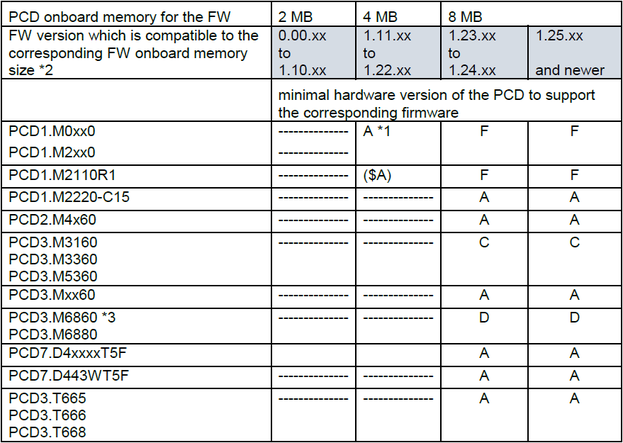
Do use at least the PG5 firmware downloader version 2.1.311 or newer (included in PG5 patch 2.1.311 or newer) to prevent the loading of the FW 1.24.xx, 1.26.xx or newer to a not compatible PCD
Firmware 1.28.59 (only BACnet firmware) (January 2024)
Main corrections
- BACnet: MI/MO/MV objects, invalid values for Alarm_Values and Fault_Values are rejected
- BACnet: BI/BV/BO objects, present value of can only be 0 or 1
- BACnet: COMMAND object, present value writing returns an error if bigger that the number of actions
- BACnet: Trendlog objects, property value check is done according to specifications
- BACnet: Limit COV subscription to 3000 and send PDU-Error if length of response is too big
- BACnet: Disable I-Have response when state is disable / disable-init
- BACnet: Calendar Object Date List, don’t allow wild card in this property entries
- BACnet: writing invalid array to Array properties returns correct Error code
- BACnet: Pulse Converter Object, send out-of-range PDU-Error if count processing is < 0
- BACnet: Controller goes to HALT with SWTO error
- BACnet: MS/TP Controller goes to HALT with SWTO error
- BACnet: Schedule accepts Sundays in Week and Day
- BACnet: GetEnrollmentSummary: correct reply if list is empty
Firmware 1.28.51 (April 2022)
Main corrections
- All PCD’s: Saia PCD Modbus diag does not work if diag flag > 9999
- All PCD’s: SNTP and hardware RTC is diverging from more than 2 seconds, then History message ‘RTC Fail error’ is generated
- All PCD’s: SNTP Time synchronization does not work with DHCP
- All PCD’s: E-Mails send from PCD could contain unwanted characters like 0 or others
- All PCD’s: S-Monitoring values for S-Monitoring bar graphs are sometime wrong
- All PCD’s: S-Monitoring Year graph scaling displayed wrongly
- All PCD’s: TCP, open data mode protocol, communication is blocked after rejection of 32 connections
- All PCD’s: LonIP CSF is locked when an error occurs
- PCD2.M45x0: SRXM does not support FB parameters as operand 3 and 4 for source and destination
- PCD1.M2220-C15: Watchdog LED does not follow Relay when PCD goes in STOP or HALT
- PCD3.M6880: Data exchange between CPU 0 and CPU 1 does not work reliable if STL instruction is used
- BACnet: Calendar state not updating after add/remove list element service
- BACnet: Exception schedule writing to certain array index fails
- BACnet: Schedule crashes with SWTO error
- BACnet: MS/TP client properties are not written if many values change simultaneously
- BACnet: Problem reliability & out of service, reliability is not written when oos is high
- BACnet: Web CGI commands to read BACnet platform tags like ..AddFW,Version,BACnet don’t work
- BACnet: Web scheduler/calendar templates do not work
- BACnet: PCD3.M6860 no BACnet communication on ETH2 if router is used
- BACnet: Rev 4 not working with Name based Client
- BACnet: Rev14 does not allow high limit value below 5 on analogue input
Firmware 1.28.37 (February 2019)
New features
- All PCD’s: FW extension to close all open FTP connections
- BACnet: Calendar objects have been extended with a synchronization mode. Each server calendar object can be configured as Slave or Master calendar
- BACnet: New mappings for alarming counters have been added to Notification-Class objects.
- BACnet: The PCD will now accept AcknowledgeAlarm service requests, which use complete wildcards as timestamps.
Main corrections
- All PCD’s: On S-Bus data mode, if S-Bus CRC contains a S-Bus DLE as last character then S-Bus telegram is incorrect and not accepted from S-Bus recipient. (Since FW 1.28.20)
- All PCD’s: Not all bytes are transmitted when working with MC4 or MC5 mode on F2xxx module
- All PCD’s: RS485 driver keep holding bus after a while
- All PCD’s: Http request ‘is modified’ is not handled correctly on the PCD Web-Server which lead to the effect that web project is not loaded correctly on the browser
- All PCD’s: PCD can crash when breakpoint is updated during conditional RUN
- All PCD’s: PCD can crash on download in run since FW 1.28.27.
- All PCD’s: PCD can crash on download in run when Graftec is used
- All PCD’s: PCD crashes when using browser to access the default page of PCD with "Display Root Content Enabled = YES"
- All PCD’s: RCOB does not start COB when it was stopped before with SCOB
- All PCD’s: Profibus communcation using onboard FDL port. The FCS test for SD2 telegram was not implemented correctly.
- All PCD’s: When S-Bus IP Nodelist is used it’s possible that the communication using nodes does no more work after execute a download in run
- All PCD’s: XOB parameter as Registers does not work if 16bit addressing was used
- All PCD’s: LonFT10: SNVT_obj_status and SNVT_obj_request can be used in user profiles
- PCD3.Mxx60, PCD3.T6xx, PCD1.M2xx0, PCD2.M4x60: usage of I/O media mapping slows done the cycle time 2 times in comparison to FW 1.26.xx
- PCD2.M4x60: Download LonIP config not possible
- PCD2.M4x60: RTC gets sometime corrupted data when PCD7.F7500 is used on PCD2.M4x60
- PCD2.M4x60: RTC Time is wrong after several days of run
- PCD7.D443WTxR: uBrowser use alphapad.teq even if screen is rotated by 90°
- PCD7.D443WT5R: History entry Memory ‘Lost -1’ written in the History
- BACnet; Event Enrolment does not work correctly with external reference devices.
- BACnet; When using BACNet Webvisu the memory used increase each time the scheduler is edited.
- BACnet; PCD crash when BACnet Webvisu edit scheduler.
- BACnet; BACnet WebVisu does not display correct value for the WeeklySchedule value.
- BACnet; ACK Required bit in notification message is not set according to the related NV ack_required bits
- BACnet: The PCDAlarmStatus mapping property does not work correctly.
- BACnet: Mappings, which changed to the value 0 directly after a program download, are not updated correctly on the BACnet property.
- BACnet: The Priority-Array mapping does not work correctly after startup.
- BACnet: Initialization of Puls converter count with input reference gives error
- BACnet: Fix issue with weekly scheduler.
- BACnet: Fix issue with WeekNDay entries
- BACnet: The Restore functionality over BACnet does not work, when the PCD has been reset over factory reset.
- BACnet: The Action property in the command object does not handle NULL datatype and priority entries correctly, if they are used in the ActionCommand. Additionally, the Action property can now be read via index.
- BACnet: Priority_Array entry 16 will be overwritten on startup with the last Present_Value mapping
- BACnet: Out of Service -> Value for PV overridden after reboot by Input ref
- BACnet: The Log_Buffer to csv conversion for trend-log objects does not skip time change entries
- BACnet: Unmapped Priority-Array property array entries are not stored persistent
- BACnet: BACnet configuration on the PCD is not deleted when "unlinked" from PG5
- BACnet: Change Client Time_Of_Restart mapping to Unix time
- BACnet: Client mapping - Threshold is not implemented correctly
- BACnet: Mapped Reliability properties within analogue objects does interfere with the objects functionality. When the Reliability is mapped, the mapping has not full control over the property value.
- BACnet: The program download fails, when the BACnet config contained notification-class objects with event-counter mappings
- BACnet: BACnet Trend-Log(-Multiple) data can’t be retrieved as csv data
- BACnet: The SubscribeCOVProperty service can’t be executed on complete Priority_Arrays
Firmware 1.28.16 (June 2017)
New features
- All PCD's: When push button is pressed while power on then do not update FW from FS in order to execute a delete all.
- PCD1.M0xx0/M2xx0, PCD2.M4x60, PCD3.Mxx60, PCD3.M6880 and PCD3.T665/T666/T668:
Enhancement for HTTP server to transparently support sending compressed files.
Main corrections
- All PCD's SBUS parity mode, correction when NAK character is received as first byte of response.
- All PCD's: When download new Ethernet-RIO Program with the option ‘Delete all backups’ it can happen that the RIO is not commission and no goes no more in ‘data exchange mode’ until the PCD reboots.
- All PCD's: When RIO name is not in upper case the RIO file is not updated until a restart is executed.
- All PCD's: When RIO file is downloaded with download changed RIO file then RIO file is not sent to RIO until a restart is executed.
- All PCD's: Ethernet Frame Padding Information Leakage fixed (CVE-2017-9628)
- All PCD's: The Modbus CSF CloseSRPort does not free the port then a open/SASI call give an error and the port does not work.
- PCD1.M2xx0 PCD1.M22x0 PCD2.M4x60: PCD can crash while power down when XOB 0 is programmed.
- PCD1.M2xx0 PCD1.M22x0 PCD2.M4x60: MC0 mode with start/stop flag working again.
- PCD7.D443WT5R: Alarming does not work since 1.28.00 FW.
- PCD7.D443WT5R: When watchdog timeout occurs PCD7.D443WT5R does't reboot and stays locked.
Firmware 1.28.11 (Arpil 2017)
New features
- All PCD's: Support of BACnet Revision 14
Main corrections
- All PCD's: Various Open Data Mode fixes: Read Timeout enhancement, Client Connection timeout and Client Keep alive with anonymous port issue fixed
- All PCD's: Modbus RTU on all ports but specially on the F2xx module has been corrected to handle the response timeout processing in the case that the response is just occurring at the moment of the timeout.
- All PCD's: Battery status shows FAIL also if battery module is missing.
All PCD's: Various minor issues fixed - PCD1.M2xx0 & PCD3+: 38400/115200 baud settings adjustment
- PCD2.M4x60: PCD7.F7500 initialization
-
Why the RS-485 S-Bus communication between the PCD master and the slave does fail sometime, if FW 1.28.20…1.28.33 is used? (FAQ #102026)
It’s possible that the some of the S-Bus telegrams transferred from the PCD S-Bus master to the S-Bus slaves over RS485 are malformed, and the S-Bus slave does reject the request from the master.
This could lead to the situation that for example the PCD S-Bus master don’t receive actual values from E-Line RIO’s or that the program download of a PCD program from the PC to a Slave PCD which is located behind a gateway PCD, fails.
The firmware update of the PCD who act as S-Bus master with a firmware 1.28.34 or newer solves the issue.
Symptoms
Programmable PCD devices that act as S-BUS master on RS485 with PCD Firmware >= 1.28.20 and <= 1.28.33 get no answer from Slave devices on some of the S-Bus master requests, although S-BUS address, baud rate, polarity and line termination are ok.Possible effects of the issue
Until now we have found that E-Line RIO communication seems to be more concerned of this problem than e.g. RS485 S-Bus data communication between CPU's.
In some of the cases the effect was, that it was not possible to write to the outputs of the E-Line RIO's or the change of values on the E-Line RIO Inputs was not transfered to the S-Bus master.
With the concerned Firmware it might be very difficult or impossible to download the user program over a gateway connection.
PCD Firmware 1.28.x for all programmable PCD types are concerned.
Reason
The reason of the issue is a error in the Firmware of the S-Bus master.
The problem on the Firmware is, that telegrams which contain DLE characters (B5 or C5) as last character of the telegram (CRC) where malformed because the last character is missing.Since the CRC is calculated during runtime this malformed S-Bus request occurs depending of the content of the S-Bus request.
The (malformed) CRC is transfered with the S-Bus request from the master to the slave.
If now the slave receives the S-Bus request and the received CRC does not fit with the calculated CRC, then the S-Bus slave reject the S-Bus telegram.
Solution
In case you use the concerned Firmware on an installation with RS485 S-Bus Data communication, update the S-Bus master PCD to the newest available Firmware >= 1.28.34.
-
PCD Firmware 1.28.16 or 1.24.69 fix the Ethernet frame padding information leakage (FAQ #102011)
This Firmware do fix the issue CVE-2017-9628 related to Ethernet frame padding information leakage.
To avoid any problems in relation to this leakage we do recommend strongly to update to the latest Firmware
1.28.16 / 1.24.69 or newer as mentioned on the security upgrade section on this web-page.
Impact of the CVE-2017-9628
IEEE 802 specifies that packets have a minimum size of 56 bytes.
The Ethernet driver is expected to fill the data field with octets of zero for padding when packets are less than 56 bytes.
Resident memory and other data are used for padding in some implementations that could cause information leakage.
This attack is passive; the attacker can only see data that the affected devices sent out as part of a packet.
Vulnerability overview of the CVE-2017-9628
The previous implementation of firmware allowed other data from a known area of memory to be used in this field and could exfiltrate or leak data. -
What are the differences between the COSinus firmwares FW 1.28.11 and FW 1.28.51? (FAQ #102010)
In April 2022:
the COSinus FW 1.28.51 was introduced into production for the systems:- PCD1.M0xx0/M2xx0, PCD2.M4x60, PCD3.Mxx60 and PCD3.M6880.
In February 2019:
the COSinus FW 1.28.37 was released as maintenance version for the systems:- PCD1.M0xx0/M2xx0, PCD2.M4x60, PCD3.Mxx60, PCD3.M6880 and PCD3.T665/T666/T668.
In June 2017:
the COSinus FW 1.28.16 was introduced into production for the systems:- PCD1.M0xx0/M2xx0, PCD2.M4x60, PCD3.Mxx60, PCD3.M6880 and PCD3.T665/T666/T668.
the BACnet and LonIP FW 1.28.16 was put into production, which do support the BACnet Revision 14.
To support the BACnet Revision 9 it's necessary to use the PCD and the BACnet FW 1.26.xx.Attention:
The firmware 1.28.xx or later can be used only on the following PCD's with 8 MB onboard firmware memory:
PCD1.M0xx0/M2xx0, PCD2.M4x60, PCD3.Mxx60, PCD3.M6880 and PCD3.T665/T666/T668
The table below does show the hardware dependencies in relation with the COSinus firmware versions
Do use at least the PG5 firmware downloader version 2.1.311 or newer (included in PG5 patch 2.1.311 or newer) to prevent the loading of the FW 1.24.xx, 1.26.xx or newer to a not compatible PCD
Firmware 1.28.51 (April 2022)
Main corrections
- All PCD’s: Saia PCD Modbus diag does not work if diag flag > 9999
- All PCD’s: SNTP and hardware RTC is diverging from more than 2 seconds, then History message ‘RTC Fail error’ is generated
- All PCD’s: SNTP Time synchronization does not work with DHCP
- All PCD’s: E-Mails send from PCD could contain unwanted characters like 0 or others
- All PCD’s: S-Monitoring values for S-Monitoring bar graphs are sometime wrong
- All PCD’s: S-Monitoring Year graph scaling displayed wrongly
- All PCD’s: TCP, open data mode protocol, communication is blocked after rejection of 32 connections
- All PCD’s: LonIP CSF is locked when an error occurs
- PCD2.M45x0: SRXM does not support FB parameters as operand 3 and 4 for source and destination
- PCD1.M2220-C15: Watchdog LED does not follow Relay when PCD goes in STOP or HALT
- PCD3.M6880: Data exchange between CPU 0 and CPU 1 does not work reliable if STL instruction is used
- BACnet: Calendar state not updating after add/remove list element service
- BACnet: Exception schedule writing to certain array index fails
- BACnet: Schedule crashes with SWTO error
- BACnet: MS/TP client properties are not written if many values change simultaneously
- BACnet: Problem reliability & out of service, reliability is not written when oos is high
- BACnet: Web CGI commands to read BACnet platform tags like ..AddFW,Version,BACnet don’t work
- BACnet: Web scheduler/calendar templates do not work
- BACnet: PCD3.M6860 no BACnet communication on ETH2 if router is used
- BACnet: Rev 4 not working with Name based Client
- BACnet: Rev14 does not allow high limit value below 5 on analogue input
Firmware 1.28.37 (February 2019)
New features
- All PCD’s: FW extension to close all open FTP connections
- BACnet: Calendar objects have been extended with a synchronization mode. Each server calendar object can be configured as Slave or Master calendar
- BACnet: New mappings for alarming counters have been added to Notification-Class objects.
- BACnet: The PCD will now accept AcknowledgeAlarm service requests, which use complete wildcards as timestamps.
Main corrections
- All PCD’s: On S-Bus data mode, if S-Bus CRC contains a S-Bus DLE as last character then S-Bus telegram is incorrect and not accepted from S-Bus recipient. (Since FW 1.28.20)
- All PCD’s: Not all bytes are transmitted when working with MC4 or MC5 mode on F2xxx module
- All PCD’s: RS485 driver keep holding bus after a while
- All PCD’s: Http request ‘is modified’ is not handled correctly on the PCD Web-Server which lead to the effect that web project is not loaded correctly on the browser
- All PCD’s: PCD can crash when breakpoint is updated during conditional RUN
- All PCD’s: PCD can crash on download in run since FW 1.28.27.
- All PCD’s: PCD can crash on download in run when Graftec is used
- All PCD’s: PCD crashes when using browser to access the default page of PCD with "Display Root Content Enabled = YES"
- All PCD’s: RCOB does not start COB when it was stopped before with SCOB
- All PCD’s: Profibus communcation using onboard FDL port. The FCS test for SD2 telegram was not implemented correctly.
- All PCD’s: When S-Bus IP Nodelist is used it’s possible that the communication using nodes does no more work after execute a download in run
- All PCD’s: XOB parameter as Registers does not work if 16bit addressing was used
- All PCD’s: LonFT10: SNVT_obj_status and SNVT_obj_request can be used in user profiles
- PCD3.Mxx60, PCD3.T6xx, PCD1.M2xx0, PCD2.M4x60: usage of I/O media mapping slows done the cycle time 2 times in comparison to FW 1.26.xx
- PCD2.M4x60: Download LonIP config not possible
- PCD2.M4x60: RTC gets sometime corrupted data when PCD7.F7500 is used on PCD2.M4x60
- PCD2.M4x60: RTC Time is wrong after several days of run
- PCD7.D443WTxR: uBrowser use alphapad.teq even if screen is rotated by 90°
- PCD7.D443WT5R: History entry Memory ‘Lost -1’ written in the History
- BACnet; Event Enrolment does not work correctly with external reference devices.
- BACnet; When using BACNet Webvisu the memory used increase each time the scheduler is edited.
- BACnet; PCD crash when BACnet Webvisu edit scheduler.
- BACnet; BACnet WebVisu does not display correct value for the WeeklySchedule value.
- BACnet; ACK Required bit in notification message is not set according to the related NV ack_required bits
- BACnet: The PCDAlarmStatus mapping property does not work correctly.
- BACnet: Mappings, which changed to the value 0 directly after a program download, are not updated correctly on the BACnet property.
- BACnet: The Priority-Array mapping does not work correctly after startup.
- BACnet: Initialization of Puls converter count with input reference gives error
- BACnet: Fix issue with weekly scheduler.
- BACnet: Fix issue with WeekNDay entries
- BACnet: The Restore functionality over BACnet does not work, when the PCD has been reset over factory reset.
- BACnet: The Action property in the command object does not handle NULL datatype and priority entries correctly, if they are used in the ActionCommand. Additionally, the Action property can now be read via index.
- BACnet: Priority_Array entry 16 will be overwritten on startup with the last Present_Value mapping
- BACnet: Out of Service -> Value for PV overridden after reboot by Input ref
- BACnet: The Log_Buffer to csv conversion for trend-log objects does not skip time change entries
- BACnet: Unmapped Priority-Array property array entries are not stored persistent
- BACnet: BACnet configuration on the PCD is not deleted when "unlinked" from PG5
- BACnet: Change Client Time_Of_Restart mapping to Unix time
- BACnet: Client mapping - Threshold is not implemented correctly
- BACnet: Mapped Reliability properties within analogue objects does interfere with the objects functionality. When the Reliability is mapped, the mapping has not full control over the property value.
- BACnet: The program download fails, when the BACnet config contained notification-class objects with event-counter mappings
- BACnet: BACnet Trend-Log(-Multiple) data can’t be retrieved as csv data
- BACnet: The SubscribeCOVProperty service can’t be executed on complete Priority_Arrays
Firmware 1.28.16 (June 2017)
New features
- All PCD's: When push button is pressed while power on then do not update FW from FS in order to execute a delete all.
- PCD1.M0xx0/M2xx0, PCD2.M4x60, PCD3.Mxx60, PCD3.M6880 and PCD3.T665/T666/T668:
Enhancement for HTTP server to transparently support sending compressed files.
Main corrections
- All PCD's SBUS parity mode, correction when NAK character is received as first byte of response.
- All PCD's: When download new Ethernet-RIO Program with the option ‘Delete all backups’ it can happen that the RIO is not commission and no goes no more in ‘data exchange mode’ until the PCD reboots.
- All PCD's: When RIO name is not in upper case the RIO file is not updated until a restart is executed.
- All PCD's: When RIO file is downloaded with download changed RIO file then RIO file is not sent to RIO until a restart is executed.
- All PCD's: Ethernet Frame Padding Information Leakage fixed (CVE-2017-9628)
- All PCD's: The Modbus CSF CloseSRPort does not free the port then a open/SASI call give an error and the port does not work.
- PCD1.M2xx0 PCD1.M22x0 PCD2.M4x60: PCD can crash while power down when XOB 0 is programmed.
- PCD1.M2xx0 PCD1.M22x0 PCD2.M4x60: MC0 mode with start/stop flag working again.
- PCD7.D443WT5R: Alarming does not work since 1.28.00 FW.
- PCD7.D443WT5R: When watchdog timeout occurs PCD7.D443WT5R does't reboot and stays locked.
Firmware 1.28.11 (Arpil 2017)
New features
- All PCD's: Support of BACnet Revision 14
Main corrections
- All PCD's: Various Open Data Mode fixes: Read Timeout enhancement, Client Connection timeout and Client Keep alive with anonymous port issue fixed
- All PCD's: Modbus RTU on all ports but specially on the F2xx module has been corrected to handle the response timeout processing in the case that the response is just occurring at the moment of the timeout.
- All PCD's: Battery status shows FAIL also if battery module is missing.
All PCD's: Various minor issues fixed - PCD1.M2xx0 & PCD3+: 38400/115200 baud settings adjustment
- PCD2.M4x60: PCD7.F7500 initialization
-
Lon Bindings lost after power off / on with FW 1.26.15 (FAQ #101999)
With Firmware >= 1.26.00, after Power off / on of the PCD, the LON bindings are lost.
Symptoms
The LON communication don’t works anymore after power off/on. In the commissioning tool, e.g. NL220 the Lon node is getting “red” after the function Network –>Test
Reason
In the FW 1.26.xx there is a problem with the file update on the Flash cards, the bindings are only updates in the memory but the operation to save them to the filesystem fails. Therefore the binding information is lost after power off / on.
Solution
The correction is done with >= 1.26.24. The firmware of the PCD and the LonIP FW have to be updated.
In the commissioning tool e.g. NL220 a Network -> Repair function has to be executed on the node.
Only the FW >= 1.26.00 are concerned. (e.g. FW 1.24.xx is not concerned of this problem)
-
What are the differences between the COSinus firmwares FW 1.24.67 and FW 1.26.31? (FAQ #101987)
In June 2017:
the COSinus FW 1.26.31 was released as maintenance version for the systems:- PCD1.M0xx0/M2xx0, PCD2.M4x60, PCD3.Mxx60, PCD3.M6880 and PCD3.T665/T666/T668.
the BACnet and LonIP FW 1.26.31 was released as maintenance version, which do support the BACnet Revision 9.
To support the BACnet Revision 14 it's necessary to use the PCD and the BACnet FW 1.28.xx.In March 2017:
the COSinus FW 1.26.28 was introduced into production for the systems:- PCD1.M2220, PCD1.Mxx60, PCD2.M4x60, PCD3.Mxx60, PCD3.M6880 and PCD3.T665/T666/T668.
the BACnet and LonIP FW 1.26.28 was introduced into production
In June 2016:
the COSinus FW 1.26.15 was introduced into production for the systems:- PCD1.M0xx0, PCD1.M2xx0, PCD2.M4x60, PCD3.Mxx60 and PCD3.M6880.
The COSinus FW 1.26.16 was introduced into production for the systems: PCD3.T665/T666/T668.
The BACnet and LonIP FW 1.26.15 was introduced into production
Attention:
The firmware 1.26.xx or later can be used only on the following PCD's with 8 MB onboard firmware memory:
PCD1.M0xx0/M2xx0, PCD2.M4x60, PCD3.Mxx60, PCD3.M6880 and PCD3.T665/T666/T668
The table below does show the hardware dependencies in relation with the COSinus firmware versions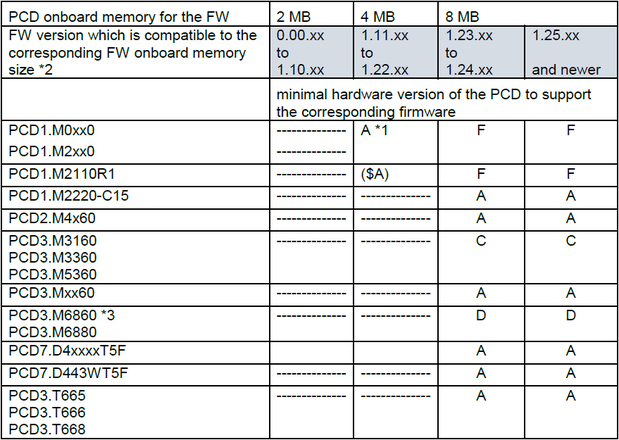
Do use at least the PG5 firmware downloader version 2.1.311 or newer (included in PG5 patch 2.1.311 or newer) to prevent the loading of the FW 1.24.xx or 1.26.xx to a not compatible PCD.
Firmware 1.26.31 (June 2017)
Main corrections
- All PCD's SBUS parity mode, correction when NAK character is received as first byte of response.
- All PCD's: When download new Ethernet-RIO Program with the option ‘Delete all backups’ it can happen that the RIO is not commission and no goes no more in ‘data exchange mode’ until the PCD reboots.
- All PCD's: When RIO name is not in upper case the RIO file is not updated until a restart is executed.
- All PCD's: When RIO file is downloaded with download changed RIO file then RIO file is not sent to RIO until a restart is executed.
- All PCD's: Ethernet Frame Padding Information Leakage fixed (CVE-2017-9628)
- All PCD's: The Modbus CSF CloseSRPort does not free the port then a open/SASI call give an error and the port does not work.
- PCD1.M2xx0 PCD1.M22x0 PCD2.M4x60: PCD can crash while power down when XOB 0 is programmed.
- PCD1.M2xx0 PCD1.M22x0 PCD2.M4x60: MC0 mode with start/stop flag working again.
Firmware 1.26.28 (March 2017)
Improvements
- Text Ram can now be cleared (all chars are set to blank space) with the cgi interface by writing a zero length string.
- Ping request on ETH2 over rooter from different sub net.
- LonIP Mapper improvement
- Web Server RAM Disk increased
- Error Led not set on IR overflow
Main corrections
- All PCD's: MC0 communication with F2xx module and related communication flags are handled correctly in case of transmission
- All PCD's: Text Ram can now be cleared (all chars are set to blank space) with the cgi interface by writing a zero length string.
- All PCD's: Multiple AlarmLists with similar names will now be "initialized" correctly.
- All PCP's: TCP client keep alive is not working when anonymous port is used.
- All PCD's: Profi-SBus GWY does not wor, Profi-SBus Master/GWY stop working after cable is re plugged.
- All PCD's: PCD crash when use DIGI(R)/DIGO(R) with first parameter as FB parameter.
- All PCD's: Correction for modbus RTU communication over F2xx communication module
- All PCD's: When RIO file is downloaded with download changed RIO file then RIO file is not sent to RIO until a restart is executed.
- PCD1.M22x0: While changing the analog output value, the Watchdog is switching. Switching the Watchdog Relais over the corresponding flag has no influence.
- PCD2.M4x60: Sometimes the Profibus DP module is not initialized correctly on startup.
- PCD2.M5xx0: When Restore program because of a missing or dead battery configuration (SBus/IP,..) is not restored correctly.
- PCD2.M5xx0: Modbus RTU on all ports but specially on the F2xx module has been corrected to handle the response timeout processing in the case that the response is just occuring at the moment of the timeout.
- PCD2.M5xx0: Sometimes config is lost after download project with self-download tool.
- PCD3.Mxxx0: Battery status shows FAIL also if battery module is missing.
- PCD3.Mxxx0: FTP server processing with long commands resolved.
- PCD3.Mxxx0: Modbus RTU on all ports but specially on the F2xx module has been corrected to handle the response timeout processing in the case that the response is just occuring at the moment of the timeout.
- PCD3.Mxxx0: Sometimes config is lost after download project with self-download tool.
- PCD3.Mxx60: Profi-SBus/DP/SIO does not work on port 2 on PCD3.M3x60 & PCD3.M5360.
- PCD3.M6860: Ping request from over rooter from different sub net is not respond.
- PCD3.M6860/M880: Profibus/S-IO/Profi-SBus does not work stable.
- PCD3.M6860: Set PCD to HALT if there is no or incompatible media transfer between the two CPU's.
- PCD3.T66x: The RIO Status web page does not allow to clear the diagnostics.
- BACnet: The memory usage of the BACnet FW was increasing for every SubscrobeCOVProperty service, which has been received by the PCD.
- BACnet: A client configuration for Priority_Array properties in commadable objects (e.g. Analog-Value) does now allow reading (ReadProperty/COV) and writing (WriteProperty service to server) at the same time.
Firmware 1.26.15 (June 2016)
New features
- Support of PCD1.M2220-C15
- Support of PCD2.M4x60
- Support of PCD3.M3160/PCD3.M3360/PCD3.M5360
- Support of PCD3.M6880, PCD3.T668 Standby-CPU-System
Improvements
- PCD2.M4x6x, support Interrupt when reaching the configured ref Value
- PCD1.Mxxx0, PCD2.M4x60, PCD3.Mxx60 PCD7.D4xx: Increase None Volatile Register to 1000
- PCD3.T666/8: Increase the User Program Memory for to 256k
- PCD3.T66x: Support the ESIO manager use tag values for IP address
- PCD2/3.F2xx modules Baudrate: Support 300/600/1200 baud settings for in MC mode.
- S-Monitoring: In bar displays where the current time is visible, the average for the period is calculated not in a optimal way (time slice, ref time, is a bar). New it's displayed in seconds
Main corrections
- PCD3.M6860/M6880: When update FW on extension using the file system after update the extension FW can stay in an endless loop
- PCD3.M6880: crash wen Timmer/Counter is mapped in the Read Symbols
- PCD3.M6880: PCD can crash with MuKe Error when use the SBus GWY in parallel with modbus TCP
- PCD3.M6880: Standby CPU1 does not always HALT when CPU0 crash
- PCD3.M6880: CPU0 to 1 From Read data communication sometimes stop works
- PCD3.M6880: Add a Transmit Error diagnostic tag "DataTxErrors"
- PCD3.Mxxx0: Battery module on IO slot 3 does not show battery status in history
- PCD3.Mxxx0/PCD1.M2xx0: Some baudrates on onboard ports are not correct
- PCD2.M4x60: RTC read/write locks the PCD for about 30ms
- PCD2.M4x60: Modem does not work because of the not working DCD
- PCD3.T66x: Add ELine CSF library
- PCD3.T66x: Serial com does not work with SASI instruction
- PCD3.T66x: CSF Modbus Server Init gives an error when port 502 is used becasue this port is already open
- PCD7.D443WT5R: Assignation/Configuration of port 1 should return an error because port 1 is not supported
- PCD7.D443WT5R: Remove IO access from the system. PCD goes now in HALT with "INVALIDE OPCODE"
- PCD2.W220 with Pt1000: Significant deviation between singel channels
- BACnet: List Properties (like Date_List, Exception_Schedule, ...) could disappear after a PCD restart, if a WriteProperty request with an empty list value has been received for these properties before the restart. This behavior was only present for persistent properties
- BACnet: The Log_Buffer property of a Trend-Log object could not be read anymore using the ReadRange service, after a Event-Log or Trend-Log-Multiple has been read via ReadRange
- BACnet: Writing a single analog output channel is not working. The output is not changing. Writing output channels over the mapped functionality is working
- BACnet: PCD with BACNet loops with restart if program has "INVALIDE OPCODE"
- Restart Warm does not work
- SBus ELine has sometimes retries
- When create a Text/DB the backup fails until a restart is done
- PCD Crash with BUS ERROR on STXT instruction when text is empty
- Modem does not work correctly
- Modem does not work or PCD crash when modem is configure
- PCD can crash when error occurs in Modbus RTU
- The PCD crash if a BITI is executed with number as FB parameter
- PCD crash when use Profi-S-Bus Master
- Sometimes the program is lost when update FW from 1.24.xx to 1.26.xx
- MOVX/DIVX function where not working on Task or Temporary data when use indexed
- Add config tag value for GWY mode "data_no_secure" to deasble the secure data mode
- Not possible to upload a file through the Web server FTP interface (ftp.cgi or ftp.json) if that file starts with a white space character (either a space or a tab)
- CSF CopyDBBytesToR crash when destination is bigger than last Register
- Diagnostic Flags in S-Bus Master mode are not correct if there are collisions on the RS-485 network
- CSF Backup/Restore Media does give an error on restore when data change while backup/restore
- MOV instruction with type position as FB parameter gives error flag and fails
- Web-Alarm: Fix alarming color with "group color mode" and group bigger than 8
-
What is the meaning of the PCD history entry ‘FWDnld UnknownFW’? (FAQ #101959)
It’s possible that after a FW update of the PCD to the FW 1.20.xx, 1.22.xx or 1.24.xx there is a entry in the FW history ‘FWDnld UnknownFW’ after the history line ‘FWDnld 1.2x.xx PLC CLASSIC’ as shown on the image below.
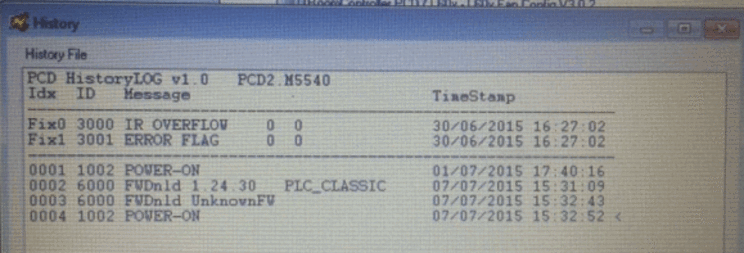
The history message ‘FWDnld UnknownFW’ was caused by an error in the old FW of the PCD and does have no signification.
Just ignore this message and clear the history messages.
-
How to find more information based on the error message "SF not loaded"? (FAQ #101568)
In case an FBox library (or an IL program) uses a functionality which is not implemented in the PCD firmware, the PCD will not go in run but display the error message "SF not loaded" (e.g. in the PCD history or in the Online Configurator).
Symptom
After the download of a program a SBC-NT based PCD (e.g. PCD3) does not go in run but remains in halt. When going online with the Online Configurator a message "SF not loaded" is displayed.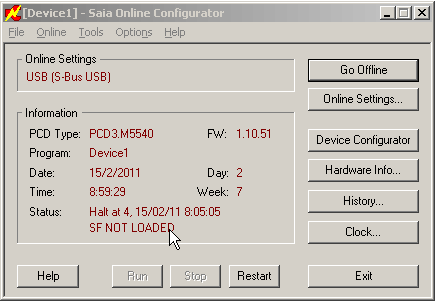
Reason
The user program uses a functionality which is not implemented in the firmware (and therefore the PCD can not run the user program).
Solution
The solution is either updating the firmware, or avoiding the CSF which leads to the problem.
In case it is not know which CSF is responsible for the "SF not loaded", the SF library can be found based on the program line indicated by the Online Configurator (the program line is indicated with "Halt at xxx" in the Status; in the screenshot above the CSF is on program line 4). By using the Online Debugger, this CSF can be displayed by typing "DP4C10"):
Display Program 4 Count 10 (Enter)
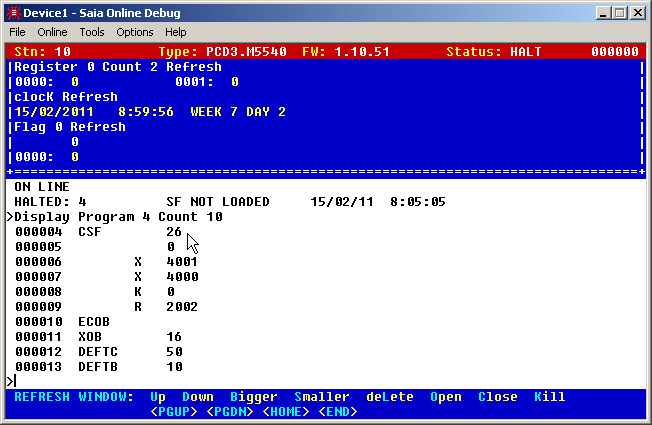
In this case, the CSF calls the SF library 26 (which is not implemented in the Firmware 1.10.51 which is used above).
How to know the functionality based on the library number?
Below you can find a list of the most commonly used System Function libraries (and in which FBox libarary they are used):- SF library 0: S.SF.IP (e.g. Open Data Mode)
Used by several IP communication drivers such as EIB/Net and for reading or writing the IP address of the PCD. - SF library 2: System library
Used by FBoxes for reading the Serial number - SF library 4: S-Net library
E.g. Used by FBoxes for Profi-S-Bus and Ether-S-Bus - SF library 6: S.SF.DBLib (e.g. CopyTextBytes), previously the "ApplicationLib" for CopyText
E.g. used by the Modem FBox library, HDLog to File library. - SF library 7: File System library
E.g. used by the FBoxes for the File System or "HDLog to File" - SF library 9: IP Services (EMail, PPP, DNS, SNMP etc.)
E.g. used by the EMail library and the WAA (Wide Area Automation) FBox library - SF library 10: S-Web Alarming library
E.g. used by the S-Web Alarming FBoxes and the DDC Suite - SF library 13: Modbus library
E.g. used by Modbus and the P-Bus FBox library - SF library 19: LON over IP library
used by LON over IP functions - SF library 22: SPI framing protocol for PCD2/3.F2xx(x)
e.g. used by the M-Bus library 2.6.100 and later - SF library 23: Energy Manager library
- SF library 25: LON FT library
- SF library 27: ELine library for ELine modules
Since PCD firmware version 1.24.xx
The single function codes (second line of the CSF call, "0" in the screenshot above) of the relevant libraries can be found in the definition files in folder
c:\Documents and Settings\All Users\Saia-Burgess\PG5_20\Libs\SF\*.lib
(e.g. SFModbusLib_en.lib for the functions of the Modbus library. - SF library 0: S.SF.IP (e.g. Open Data Mode)
-
What does CSF stand for? (FAQ #101566)
As the "original" Instruction List Set (with the mnemonics STH, OUT etc.) could not be extended by an unlimited amount of new instructions, the call of new features such as the Open Data Mode, Sending of EMails etc. is realised with so called SFs (which stands fro "System Function"). These SFs are called using CSF instructions (Call System Function).
What is a SF library?
A System Function library is a a set of functions which are implemented in the firmware and which can be called with the IL mnemonic CSF. Usually one SF library contains several functions which are related to each other. A CSF expects the SF library and the function from this library, together with a set of parameters (described in the online help of the SF library which can be found in the IL Editor SEdit from PG5 2.0).
How is a CSF used?
In the user program a SF function is called using the mnemonic CSF, followed by the library, the function and the parameters:
CSF [cc] Library
Function
Parameter 1
Parameter 2
...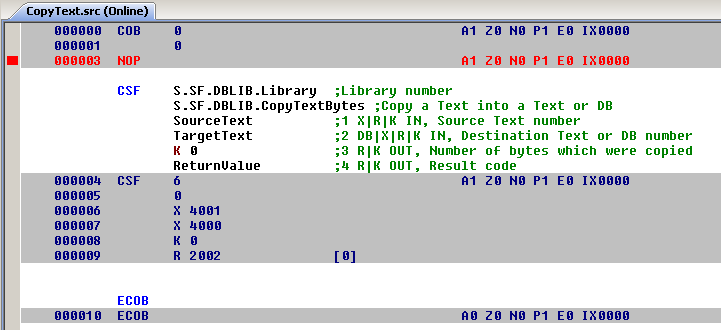
This can be done from inside an FBox, or directly from an IL program (as the engineering is faster using the FBoxes, the most CSFs are called from FBox libraries).
The "translation" between meaningful names (e.g. S.SF.DBLIB.CopyTextBytes) and the code which is used by the firmware is done by PG5. For a list of the most commonly used SF libraries, please refer to FAQ 101568. -
Overview of the current production firmware versions (FAQ #101304)
This FAQ contains an overview over the firmware versions currently used in production (which means that this firmware version is installed in our production facility).
Firmware versions used in production
The following firmware versions are currently used in production. For more information regarding the relevant firmware, please refer to the version information document of the according page.
PCD firmware versionsPCD System Firmware Date of introduction Remarks PCD1.M1x0 0F1 April 2010 PCD1.M0xx0 1.28.51 April 2022 PCD1.M2xx0 1.28.51 April 2022 PCD1.M2220-C15 1.28.51 April 2022 PCD2.M150 0F1 April 2010 PCD2.M170 0F1 April 2010 required for PCD7.R400 delivered after April 2010 PCD2.M480 1.08.53 April 2010 required for PCD7.R400 delivered after April 2010 PCD2.M5xx0 1.24.69 August 2017 PCD2.M4x60 1.28.51 April 2022 PCD3.Mxxx0 1.24.69 August 2017 PCD3.Mxx60 1.28.51 April 2022 PCD3.M6860 1.28.51 April 2022 PCS1.Cxxx 0F0 March 2010
MB Panel firmware versionsPCD System Firmware Date of introduction Remarks PCD7.D4xx_ (QVGA) 1.10.60 December 2010 Corrects backlight problem of B&W versions PCD7.D4xxV (VGA) 1.24.50 May 2012 With support for S-Web Editor 5.15.02 PCD7.D412D (SVGA) 1.18.28 May 2012 12" SVGA MB panel PCD7.D4xxE 1.18.07.04 January 2012 S-Energy Manager, image version 1.08 PCD7.D443WTxR 1.28.04 November 2016 PCD7.D4xxxT5F 1.24.50 December 2015
RIO firmware versionsPCD System Firmware Date of introduction Remarks PCD3.T660 1.14.26 Aug 2010 this system is replaced by the PCD3.T665 PCD3.T665|T666 1.28.16 August 2017 PCD3.T760 1.020 April 2010 Profibus DP and Profi-S-I/O RIO -
How to implement a software watchdog (FAQ #101285)
With an activated software watchdog the processor monitors itself and restarts the PCD in the event of a malfunction or a loop.
Description (extract from the hardware manual)
The hardware watchdog provides maximum security. However, for non-critical applications, a software watchdog may be suffcient, whereby the processor monitors itself and the CPU is restarted in the event of a malfunction or a loop.
The core of the software watchdog is the instruction SYSWR K 1000. When this is first issued, the software watchdog function is activated. This instruction must then be issued at least every 200 ms, or the watchdog will trigger and restart the controller.
Usage- Placing a "Watchdog"-FBox in a FUPLA-file is the easiest solution:
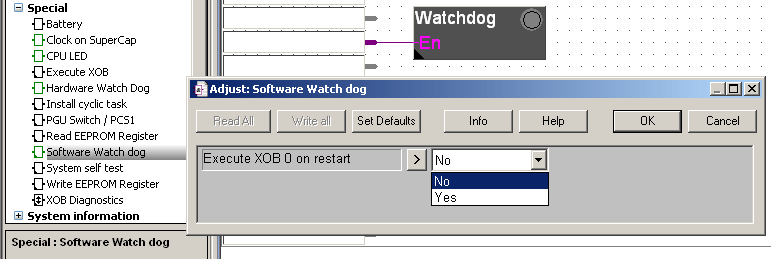
- Instead of using the FBox it is possible calling the Software Watchdog in IL (using the instruction SYSWR K 1000)
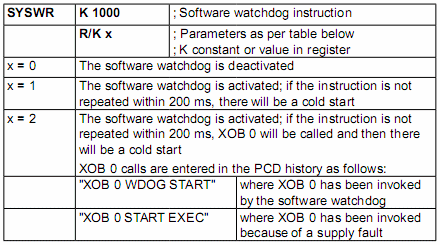
- Placing a "Watchdog"-FBox in a FUPLA-file is the easiest solution:
-
Why do I sporadically get communication errors when connecting a PCD/PCS in "Secure S-Bus Data Mode"? (FAQ #101180)
In case a "non Saia PCD® COSinus" PCD or PCS1 system is connected with "Secure S-Bus Data mode" (e.g. over a serial cable or over modem) from time to time a telegram is not answered correctly.
Symptom
A PCD or a PCS connected with another system (e.g. PC or another PCD system) using the "Secure S-Bus Data mode" does not answer a telegram from time to time. This can e.g. be seen by a red LED on transmit or receive FBoxes (or in case a PC is used, by interpreting the tracewin files).
This phenomenon can be observed on PCD1.M1x5, PCD2.M150, PCD2/4.M170 and PCS1 systems (with firmware which are supporting the "Secure S-Bus Data mode"). Saia PCD® COSinus based systems (PCD2.M480, PCD2.M5xx0 and PCD3) are not concerned.
Reason
The reason for this behavior is that the PCD/PCS does not correcly answer telegrams where the sequence number in the secure S-Bus Data Mode header is 0xC5h. This is the case in every 255th telegram.
(The character "C5" should be replaced by "C5 01" but this is not done).
Solution
Please refer to the table below for firmware version which do correctly handle the "C5" and therefore the symptom described above is avoided.System Firmware PCD1.M1x5 0F0PCD2.M150 0F0PCD2.M170 0F0PCS1 0F0 -
Why do I get a "68k add Error" when writing a text on the S-Web Server? (FAQ #101049)
When trying to write a text (with address higher than 4000) using the S-Web Server, the PCD system stopps working and in the PCD history a "68k add Error" is indicated.
Symptom
When trying to write a text (with address higher than 4000) using the S-Web Server, the PCD system stopps working and in the PCD history a "68k add Error" is indicated.
The following PCD systems are concerned:- PCD1.M1x5 with firmware version higher than 0B0
- PCD2.M150 with firmware version higher than 0E0
- PCD2/4.M170 with firmware version higher than 030
- PCS1.Cxx0 with firmware version higher than 0C0
Reason
This behaviour is not intended. Due to a problem in the firmware the write access fails.
Solution
This problem is solved in firmware version 0E6 (the version indication 0E6 is the same for all systems) which can be downloaded from the support site (www.sbc-support.ch). -
Why is the message: "Failed to get data on alarm.exe" displayed on the alarming page? (FAQ #100963)
This error message appears if the used firmware on the CPU does not support the "active and non ACK" filter for the S-Web alarming functionality (e.g. a PCD2.M150 with firmware 0D3).
Symptom
Instead of the alarm list of the S-Web alarming macro, the message "Failed to get data on alarm.exe" is displayed on the alarming page.
Reason
The reason is that the macro tries receiving the alarms filtered by the "active and not acknowledged" state of the alarms. This does only work if this feature is implemented in the according firmware.
Solution
Please update the firmware (FW) of your PCD system to the firmware supporting the according feature (see table below).System minimal FW PCS1.Cxxx 0E3PCD1.M1x5 0E3PCD2.M150 0E3PCD2/4.M170 0E3PCD2.M480 1.08.21*)PCD2.M5xx0 1.08.19PCD3.Mxxx0 1.08.23*)
*) On PCD3 and PCD2.M480 systems the "active and not acknowledged" filter has already been implemented in previous versions, but has been improved this indicated version. -
Is it possible reading the PCD "IP address" from the user program? (FAQ #100952)
Yes, this is possible by calling the system function (CSF) "IPGetLocalConfig".
Introduction
For having the possibility to read the current IP configuration from the user program, a specific System Function has been added to the firmware. This function does return the IP address, the subnet mask as well as the default gateway (each address in one register). The returned value contains the full IP address in one register (each byte or the register contains one octed of the IP address):
Example
This System Function is part of the IPD Library. In order to use these functions, the file "IPLib.inc" is to be included to the source file where the function is called. This can be done with the line:
$INCLUDE "IPLib.inc"
The IP configuration can then be read in th following way:STH F 0 ; only call the function DYN F 1 ; on a rising edge of F0 CSF H S.IPD.Library ; from the IPD library S.IPD.IPGetLocalConfig ; call the function "IPGetLocalConfig" R 0 ; (R) returned IP address R 1 ; (R) returned Subnet mask R 2 ; (R) returned Default gateway
Returned IP address (hex): 0xAC100179h
IP address in "Dot-decimal notation": 172.16.1.121 (0xACh = 172, 0x10h = 16, 0x01h = 1, 0x79h = 121)
Firmware versions supporting the GetLocalIPConfig
Please refer to the table below for the first firmware versions that support the "IPGetLocalConfig" function.PCD System minimal firmware version PCD1.M1x5 0E3PCD2.M150 0E3PCD2/4.M170 0E3PCD2.M480 1.08.21PCD2.M5xx0 1.08.19PCD3.Mxxx0 03C
Remark
The include file "IPLib.inc" from PG5 1.4.300 and earlyer versions needs to be updated in order to "know" this feature. Therefore please download the file "IPLib.inc" attached to this FAQ and replace the existing file from PG5 which is located in the "Libs/App" of PG5:
c:\Program Files\SAIA-Burgess\PG5 1_4\Libs\App\IPLib.inc -
Register corruption on a PCD1.M1x5 due to bug in firmware booter (FAQ #100645)
The booter versions up to version 0A2 can cause a register corruption after an power up of a PCD1.M1x5. The result of this problem can lead to wrong register contents after a short interruption of the power supply.
Symptom
If a booter version smaller 0A3 is used on the PCD1 it is possible that the register contents are corrupted after a short interruption of the power supply of the PCD1.M125 or PCD1.M135.
The booter version can be identfied by reading byte 800010 on the PCD1.M1x5. To do so, open the "Online Debugger" (PG5 Menu "Tools"-->"Online Debug") and type:
D Y 800010 <Enter> (for "Display memory Map")
After having done this, the booter version is indicated at the right side of the output line in the Online Debugger.Reason
This problem is caused by a bug in the booter versions up to version 0A2Solution
Update your booter to version 0A3 or newer. The easyest way to do so is using the Firmware- and Booter update tool that can be found in the PCD1.Mxxx section on the support page. This tool will establish a connection to the connected PCD in PGU mode and will download the new Booter and the Firmware. -
Error LED of PCD is lit! How to find the problem? (FAQ #100269)
There is an Error Led on nearly every PCD system that can indicate a problem on the system. Read this FAQ to learn more about the different reasons for a lit Error LED and how to find the problem causing the lit error LED.
What causes the Error LED to get lit?
There are different reasons for a lit error LED. The most common reasons are listed below:- A problem while assigning a communication port (e.g. missing communication module or wrong parameters)
- A problem while sending an S-Bus telegram (e.g. missing port assignation or invalid data array or media)
- Invalid mathematical operation (e.g. division by zero or value overflow after a multiplication)
- Index register overflow
How to find the problem in the code/configuration?
One fast way to find the problem is reading the history entries of the PCD. This may be done by using either the Online Configurator or the Online Debugger (type "Display History"). In the History some of the problems are listed explicitely (e.g. IPM not present) for further information regarding the History entries, please refer to the PG5 Help. The chapter "Messages" contains "Halt and History messages".
If only an "Error Flag" is mentioned the next task is to find the program part where the Error status-flag is set. This is to be done by using the Online Debugger:- Go online with your Fupla- or IL program.
- Open the Online Debugger and type "Restart Cold All CPUs".
- Still in the Online Debugger, type "Run Until Status-flag Error". As soon the Staus-flag "Error" is set, the PCD will be stopped. Therefore the Fupla Editor will jump to the page which actually is processed (only this page is part of the current Fupla file! If the Error isn't caused by this Fupla file, it will jump to any other page which doesn't cause the problem. Have a look at this page and the FBox with the "stop"-box on it and decide whether the problem could have been caused by this FBox!
If there isn't any FBox that could cause any problems mentioned above, repeat the procedure while beeing online with the next Fupla file of the CPU). - If you can't find the problem directly in a Fupla file, switch to the Online Debugger again. After having stopped, a line similar to the line written below will be shown:
*001234 STH I/O 48 A1 Z0 N0 P1 E1 IX COB2
This first number of this line indicates on which line of the code the problem happened: the last instruction BEFORE the line shown caused the problem (the error LED is lit after the problem). - Type "Display Program <line indicated -10> Count 15". Now you can see the instruction that caused the problem: Refer to the IL instruction Set (Online Help of IL Editor SEDIT) in order to figure out what this instruction exactly does.
If a SASI instruction causes the problem, check out the following possible reasons:
- The port is already assigned (have a look at the HW configuration and search for further SASI instructions by typing "Locate Instruction SASI" in the Online Debugger!).
Hint: Also have an eye on the SASI FBoxes you used as well as on the HMI Settings tab. - The port doesn't exist
- The SASI text isn't valid
- S-Bus support isn't enabled in the Hardware Settings but an S-Bus assignation was executed. This won't work because in this case the PCD doesn't have an S-Bus address (which is required for S-Bus communication).
If it seems as a mathematical operation caused the error, use the online debugger to run shortly before the problem-causing part of the code by typing "Run Until Instruction-Pointer Equals <instruction line shortly before problem-line>" (note that the instruction line must contain an instruction!). Once reached this line, type "sTep". In the Step-mode, you will see the contents of the PCD medias [brackets].
Remark:
The Error LED is lit in case the Status Flag E (Error status flag is set high) and no XOB 13 is programmed. In case the XOB 13 is programmed, the Error Led won't get lit but this XOB is processed immediately. -
What EPROM burner is recommended to create firmware chips for PCD's? (FAQ #100256)
We have made good experiences with the GALEP 4, for PCD1 FW together with the adaptor 210841. The local dealer for Switzerland is www.redacom.ch.
Order numbers for empty firmware chips:
PCD1.M1x0: 1x ASN 4 502 7178 (OTP27C4002), one time programmable
PCD1.M137: 1x ASN 4 502 7178 (OTP27C4002), one time programmable
PCD2.M110/M120: 2x ASN 4 502 7126 0 (27C1001-10, EPROM)
PCD2.M127: can be downloaded, refer to the product page on www.sbc-support.ch
PCD2.M150: 2x ASN 4 502 7341 0 (49F040 ,Flash-EPROM)
PCD2.M157: can be downloaded, refer to the product page on www.sbc-support.ch
PCD2.M170: chip soldered on the main board, the FW can be downloaded with PG5 *
PCD2.M177: can be downloaded, refer to the product page on www.sbc-support.ch
PCD2.M480: chip soldered on the main board, the FW can be downloaded with PG5 *
PCD2.M487: can be downloaded, refer to the product page on www.sbc-support.ch
PCD3.Mxxxx: chip soldered on the main board, the FW can be downloaded with PG5 ** Procedure to downlaod a firmware:
1) get the appropriate file from product page on the supportsite www.sbc-support.ch
2) open PG5 and go to the online-configurator; go offline
3) open the menu tools, download firmware
4) browse for the firmware file and start the download
5) load the HW configuration and the user program -
Baudrate limitation on serial ports (FAQ #100252)
Basically on PCD systems introduced before 2003 there are some restrictions to be considered about the maximum baud rate of serial communications.
Depending on firmware and hardware not all serial ports can be used at their theoretical maximum baud rate at the same time.
Systems introduced before 2003:
- All PCD1, PCD2 (except PCD2.M480), PCD4 and PCD6 as well as PCS1 classic contollers do have a baud rate limitation of 38.4 kB/s on each serial port.
For older firmware (FW) versions there is a further restriction since there is one UART responsible for two serial ports and this UART cannot handle baud rates of 38.4 kB/s on both ports at the same time. The port allocation of the UARTs is the following: first UART: port 0 and 1; second UART: port 2 and 3 etc.
This means that it isn't possible to set the concerned ports to
- 38.4 kB/s each
- one to 38.4 kB/s and one to 19.2 kB/s
- but it is possible to set one port to 38.4 kB/s and one port to 9600 B/s. - Due to more efficent port handling recent FW versions do have the following restriction (independent of production date of HW):
Amount of ports available divided by 2 equal amount of ports that can communicate at 38.4 kB/s. All the residuary ports do have a maximal baud rate of 19.2 kB/s.
In addition an UART of an PCD7.F5xx isn't able to handle 19.2 kB/s on one and 38.4 kB/s on the other port. But it is possible to assign both ports to 38.4 kB/s.
Systems introduced since 2003 (PCD2.M480 and PCD3.xxxx):
Due to faster hardware there are much higher baud rates possible on the serial ports (up to 115 kB/s)!
There is only one restriction regarding UART sharing left:
On a PCD7.F5xx it is not possible to communicate on one port at 19.2 kB/s and one the second port at 34.8 kB/s at the same time (but two times 38.4 kB/s is possible!).
This means that all ports may communicate at the maximum baud rate (which is specified in the technical information (TI) or in the manual) at the same time.FW versions that support the new port handling mentioned above:
For the following and newer FW version the following rule is valid:
Amount of ports available divided by 2 equal amount of ports that can communicate at 38.4 kB/s.
All the residuary ports do have a maximal baud rate of 19.2 kB/s.PCD system required FW version PCD1.M1x0 V081 PCD2.M110/M120 V090 PCD2.M150 V0C0 PCD2/4.M170 V010 PCD4.Mxx5 not supported PCD6.M1xx/M2xx not supported PCD6.M3x0 V040 PCS1.C8xx V090 - All PCD1, PCD2 (except PCD2.M480), PCD4 and PCD6 as well as PCS1 classic contollers do have a baud rate limitation of 38.4 kB/s on each serial port.
-
Communication interface isn't reset on SW watchdog restart with option XOB0 enabled (FAQ #100243)
Communication interfaces containing a co-processor aren't restarted after a restart caused by the software watchdog with the option "Execute XOB0". In fact only a restart cold will be executed but without resetting the communication modules.
This behaviour is a bug and will be corrected in the next FW version for the corresponding CPU. As soon as the new FW is built it will be available on the support homepage.
In the meantime it is recommended not to use the option "Execute XOB0" for the software watchdog. In this case the communication modules will be reset normally on software watchdog execution.
-
Firmware version naming of non-Saia PCD® COSinus systems (FAQ #100176)
Or "What is the difference between 0-, $- and #-firmware versions?". PCD firmware for non-Saia PCD® COSinus Systems (PCD1, PCD2.M1x0, PCD4, PCD6 and PCS) are named with 3 letters (e.g. 010, B0W or #31). This FAQ explains the meaning of these version and how to figure out which one is more recent.
The firmware version naming of non-Saia PCD® COSinus systems
In general the 3 letters (abc) are used for the following indications:- a
Definition of the kind version this firmware is. The possible versions are the following
- 0xx versions are "official production versions" (010 is the first official production version)
- Bxx versions are Beta versions which contain new features compared to the previous production version
- #xx versions are "customer bug fix versions" of an official production FW version.
- $xx versions (Pilot version) include new functionalities which are not yet fully tested. Therefore a $-version should only be used in field if the developement gives their ok! - b
The second letter defines the main production version (starting with 01x wich stands for first official production version, followed by 02x (where the 02x has important new features compared to the 01x version - c
The last letter is incremented for each build of the firmware (best observed for the bug-fix versions; #21 is based on the 020 firmware and contains corrections for the 020 firmware version)
To figure out which version the base version of a bug fix- or pilot version is, have a look at the second character of the corresponding version (e.g. the "1" of the 013). This character indicates the official production version on which the bug fix or pilot version is based on.
Examples
010 is the official production version
018 is the production bug fix version of 010; no new functions
#19 is a customer bug fix version based on 018 (and therefore also on 010); no new functions
$19 is a pilot version based on 010 with new functions. The bug fixes done for e.g. 019 probably aren't implemented in this version! (the new features will be added to the production firmware versions in 020 or later.
Remark
Early versions of the Saia PCD® COSinus systems (PCD2.M480, PCD3, PCD2.M5) up to 039 were named with this system as well. In order to reduce confusion concerning features of a firmware the new firmware naming a.bb.cc has been applied (see FAQ 100741). - a
-
Not all History entries can be found in the Online Help of PG5 (FAQ #100173)
Some history entries introduced in new firmware versions can't be found in the Online Debugger Help nor in the online help of the Online Configurator.
Below you can find recently introduced History entries that can't be found in the Help files of PG5 versions older than PG5 1.3:
History Entry Meaning Remark MEM-EXT. ERROR Extension memory corrupted Replaces "BAD TXT/DB TABLE" CONFIG TOO LONG HW setting to long to be put in EEPROM Replaces "BAD MODEM STRING" WATCHDOG FAIL Restart due to SW Watchdog was executed IPM NOT PRESENT There is an IP configuration but no IP module IPM DONT RESTART PCD has restarted but the IP module does not respond IPM HAS OLD FW The IP module FW is not compatible with the PCD FW IP FAIL SASITEXT There is an error in the SASI text IP FAIL SASI DBX There is an error in the node list configuration DBX IP FAIL NO IPM An IP function has been carried out, but the PCD has no IP configuration IP FAIL TOUT Incorrect timeout value in Ether-S-Bus master SASI text IP FAIL PORT Nbr Incorrect port number in Ether-S-Bus master SASI text Included text >3 Text nesting depth overflow SBUS PGU Error The SBUS PGU Port defined in the HW Settings isn't physically present
Error Messages concerning PCD1.M2, PCD2.M480, PCD2.M5xx0 and PCD3.Mxxx0 systems (SBC-NT)History Entry Meaning . Media corruption This message indicates that the onboard RAM has been corrupted (becaused of a discharged superCap, bad Battery or similar).
If this message is shown, all medias (R, C, F) are reset to 0, the clock is reset and the program is restored from the onboard flash (if possible).
This entry has been replaced in firmware version 1.10.04 by "Memory Lost nn"Memory Lost nn Replacement message for "Media Corruption", but with more detailed informaton why the user program was restored and the media reset (since FW version 1.10.04):
01: Bad or missing battery
02: Supercap voltage too low
03: Corrupted memory pattern/signature
04: RAM memory cleared by user (push button)
05: RAM and flash memory cleared by push button
06: Corrupted program headerNot RUN on xx7HW The HW is a xx/ type; the FW doesn't run the program on this HW SYS. TYPE ERROR The HW system type isn't correct Reg>4095 not sup The FW doesn't support more than 4095 registers SF NOT LOADED System function (CSF) isn't present CSF INV PAR NBR Invalide CSF parameter number DOUBLE TIME BASE Timebase defined more than once XOB Nbr to big XOB (Exception Organisation Block) number is too big COB Nbr to big COB (Cyclic Organisation Block) number is too big FB Nbr to big FB (Function Block) number is too big PB Nbr to big PB (Program Block) number is too big IST Nbr to big IST (Initial STep) number is too big ST Nbr to big ST (STep) number is too big TR Nbr to big TR (TRansition) number too big SB Nbr to big SB (Sequential Block) number too big FABINFO CRC FAIL Invalid CRC in the fabrication information. Please contact SBC SYSWDOG START Restart due to SW Watchdog executed NO COB No COB loaded EXTHDR EEPR FAIL Error in the EEPROM extended header IP SB GWY FAIL TCP/IP SBus gateway can't be initialised IP Ch xxx no mem No memory to open the channel on the TCP/IP Open data mode MODEM: UART fail UART doesn't accept the configuration MODEM: Reset fail Error on the modem reset command MODEM: No modem No modem or defective modem equipped on the port MODEM: Init fail Error on modem initialisation MODEM: ERROR??? Unknown modem error DIFF CFG Ch x Different configuration on Profi-S-Net port x. Verify the configuration of the port PS FAIL SASI DBX Error in the node list configuration DBX PS FAIL TOUT Incorrect timeout value in Profi-S-Bus master SASI text PS FAIL SAP Incorrect SAP number in Profi-S-Bus master SASI text PS FAIL SASITEXT Error in SASI text PSM NOT PRESENT Profi-S-Net (Profibus) configuration but no Profi-S-Net (Profibus) existent PSBus GWY FAIL Profi-S-Bus GWY can't be initialized PSBus PGU FAIL Profi-S-Bus PGU port can't be initialized
SWTO ERROR System Watchdog Timeout Error, see FAQ 100908 and 101069 BUS ERROR Internal memory access failed. Please contact your local support team, see FAQ 101069 TCPS ERROR TCPIP-Stack crash. Please contact your local support team
KRNL ERROR Internal task overload. Please contact your local support team, see 101069 BACnet incompatible FW The BACnet firmware found on the PCDx.R56x module is not compatible with the PCD firmware. Please update the BACnet firmware (see FAQ: 101010)
This message is only given with firmware version 1.10.16 and later.Bnt FAIL TL00001 An error occurred in relation to the BACnet configuration. Please refer to FAQ 101436. MANUAL HALT Indication that the PCD has been halted by pushing the Run/Halt button (implemented in firmware 1.14.23 and later) EXT DEVICE FAIL This message can be generated by PCD systems with FW 1.10.xx; The message is wrong and should be "31 CALL LEVELS".
It indicates a too big nesting level of FB/PBs (if XOB 10 is programmed, it is called in this case)RESISTERS FAIL The termination resistors of port 3 of a PCD3.M5340 can not be activated due to a firmware restriction, see FAQ 101722. INVALID PERI DBXHardware configuration contains errors (e.g. peripheral addresses, modules not supported by the firmware) -
Why is the instruction DSP not supported on Saia PCD® COSinus systems? (FAQ #100034)
The IL instruction DSP (display value on PCD7.F530 display) is not supported on Saia PCD® COSinus systems. When downloading it to a Saia PCD® COSinus system, the PCD will not go in RUN and give an error message such as "Invalid instruction" (e.g. a PCD2.M480), "Precompiler error" or "Invalid OPCODE" (on a PCD3.M5xx0 with firmware 1.10.16).
Why is the DSP instruction not supported on Saia PCD® COSinus systems?
Since it isn't allowed or even possibe to mount a PCD7.F530 card on a Saia PCD® COSinus system (e.g. a PCD2.M480, a PCD2.M5xx0, a PCD3 or a PCD1.M2xx0) the instruction for accessing the display of the PCD7.F530 is not supported by the CPU.
Remarks- The PCD7.F530 can't be mouned on a PCD2.M170 or on a PCD2.M480 because it could cause a short circuit on the internal bus connector placed right under the slot B1.
- If a user program containing a DSP instruction is downloaded the PCD2.M480 won't run the program and the error message "Halt reason: invalid instruction" will be entered in the CPU's History.
